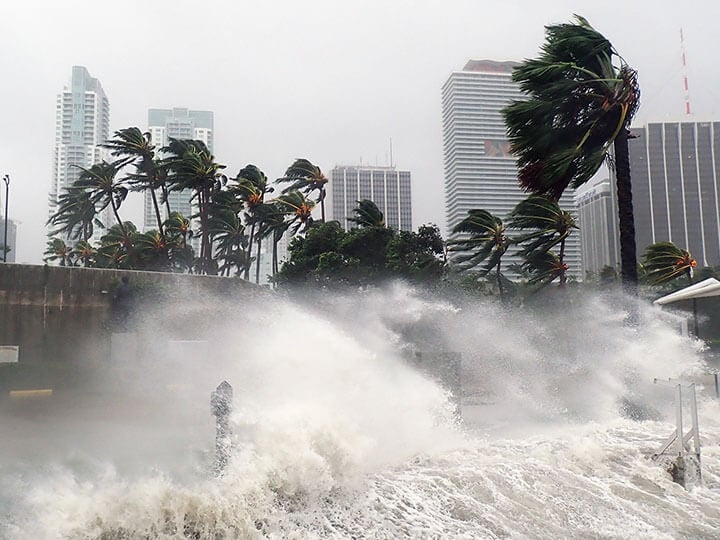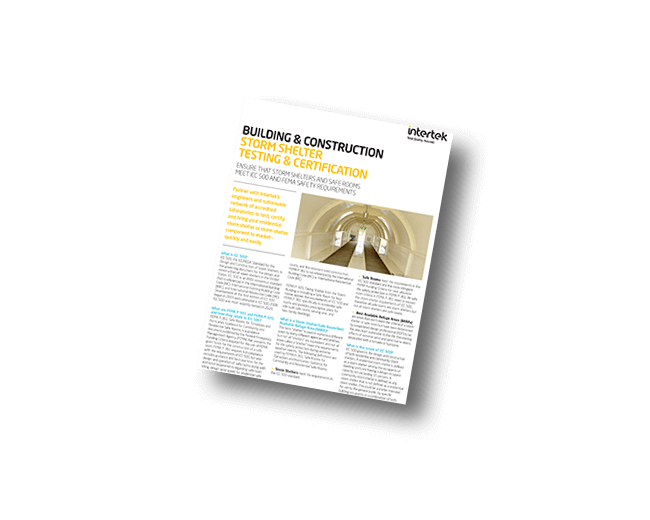ICC 500: Standard for the Design and Construction of Storm Shelters
Tornadoes and strong winds are among the most destructive forces of nature and can result in serious threats to the safety of people and property. Understanding the testing and certification requirements for areas prone to these types of weather conditions is vital to ensure your building and construction products meet the desired level of performance. When it comes to design, construction, and installation, make the safety of building occupants your number one priority.
What is ICC 500?
ICC 500, the ICC/NSSA Standard for the Design and Construction of Storm Shelters is the governing document for the design and construction of storm shelters in the United States. ICC 500 is an ANSI consensus standard that is referenced in the International Building Code (IBC), International Existing Building Code (IEBC), and International Residential Code (IRC). Development of the first edition of ICC 500 began in 2003 and culminated in ICC 500-2008. In 2014, a substantial revision to the standard was published with modifications to design and testing requirements as well as an enhanced emphasis on occupant life safety and health requirements such as means of egress, lighting, sanitation, ventilation, fire safety, and maximum occupant density. ICC 500 was most recently revised in 2020, see What has changed in 2020? below for a summary of important changes to the standard.
What are FEMA P-361 and FEMA P-320, and how they relate to ICC 500?
FEMA P-361: Safe Rooms for Tornadoes and Hurricanes: Guidance for Community and Residential Safe Rooms, is a guidance document published by the Federal Emergency Management Agency (FEMA) that presents the Funding Criteria required for the use of FEMA grant funds for the construction of a safe room. FEMA P-361 requires full compliance with the requirements of ICC 500, but also includes guidance and best practices for the design and operation of safe rooms along with additional requirements regarding safe room siting, design wind speed for residential safe rooms, and fire-resistant rated construction. FEMA P-361 is not referenced by the International Building Code (IBC) or International Residential Code (IRC).
FEMA P-320: Taking Shelter from the Storm: Building or Installing a Safe Room for Your Home, applies the requirements of ICC 500 and FEMA P-361 specifically to residential safe rooms and provides prescriptive plans for site-built safe rooms serving one- and two-family dwellings.
What is a Storm Shelter/Safe Room/Best Available Refuge Area (BARA)?
The term “shelter” is used in numerous different ways by many different agencies and entities, but not all “shelters” are equivalent and not all areas called a “shelter” meet the requirements for life-safety protection during extreme weather events. Therefore, the Federal Emergency Management Agency (FEMA) has developed specific definitions pertaining to different levels of extreme-wind refuge areas. These definitions differentiate between the area classifications as well as separate them from other “shelters”. The following definitions are used by FEMA P-361: Safe Rooms for Tornadoes and Hurricanes: Guidance for Community and Residential Safe Rooms.
- Storm Shelters meet the requirements in the ICC 500 standard.
- Safe Rooms meet the requirements in the ICC 500 standard and the more stringent FEMA Funding Criteria for near-absolute life-safety protection in FEMA P-361. All safe room criteria in FEMA P-361 meet or exceed the storm shelter requirements of ICC 500, therefore all safe rooms are storm shelters but not all storm shelters are safe rooms.
- Best Available Refuge Areas (BARAs) are areas that don’t meet the criteria of a storm shelter of safe room but have been determined by a registered design professional (RDP) to be the area least vulnerable to the life-threatening effects of extreme wind and wind-borne debris associated with a tornado or hurricane. Regardless, because these areas were not specifically designed as safe rooms or storm shelters, their occupants may be injured or killed during an extreme-wind event.
Frequently Asked Questions about ICC 500
ICC 500 governs the design and construction of both residential and community storm shelters. A residential storm shelter is defined as a storm shelter serving the occupants of dwelling units and having a design occupant capacity not exceeding 16 persons. A community storm shelter is defined as any storm shelter that is not defined as a residential storm shelter. This could be a shelter intended for use by the general public, by specific building occupants, or a combination of both.
In addition to governing the design and construction of the complete shelter, ICC 500 also includes design and performance requirements specific to the storm shelter walls, roofs, and impact protective systems. Impact protective systems are defined by ICC 500 as any assembly or device, subject to static or cyclic pressure and impact testing, installed to protect an opening in the storm shelter envelope. Typical examples of impact protective systems are windows, doors, louvers, and shutters.
The first (2008) edition of ICC 500 was adopted by Section 423 of the 2009 International Building Code (IBC) and Section R323 of the 2009 International Residential Code (IRC). Both Codes required that in addition to the other applicable requirements of the Codes, storm shelters must be constructed in accordance with ICC 500.
In 2015, the IBC adopted the 2014 edition of ICC 500 and expanded Section 423 to require the construction of an ICC 500-compliant storm shelter to serve 911 call stations, emergency operation centers, and fire, rescue, ambulance, and police stations located within the 250 MPH design wind speed zone detailed in ICC 500. A compliant storm shelter was also required for Group E occupancies with an aggregate occupant load of 50 or more that were located within in the 250 MPH design wind speed zone detailed in ICC 500. Exceptions to the shelter requirement were included for Group E day care facilities and Group E occupancies accessory to places of religious worship.
The 2018 IBC clarified that the design of facilities for use as emergency shelters after a storm event was outside the scope of ICC 500 and that these shelters must comply with the code requirements for Risk Category IV structures. The 2018 IBC also reduced the required occupant capacity of storm shelters serving Group E occupancies to the greater of either the total occupant load of all classrooms, vocational rooms, and offices within the occupancy or the occupant load of any indoor assembly space within the occupancy. Finally, the 2018 IBC added a requirement that storm shelters serving Group E occupancies must be located such that the maximum outdoor travel distance to the shelter did not exceed 1000 feet.
The 2021 IBC adopted the 2020 edition of ICC 500 and indicated that the occupancy classification of dedicated community storm shelters shall be Group A-3 while the occupancy classification of community storm shelters normally occupied for other uses shall match the normal occupancy of the space. The 2021 IRC added a requirement that the construction documents for all structural components and impact protective systems of a storm shelter be prepared and sealed by a registered design professional indicating compliance with ICC 500 unless the structural components, impact protective systems, or entire storm shelter is listed and labeled by an approved agency to comply with the requirements of ICC 500.
Chapter 3 of ICC 500 contains the structural design and testing criteria for storm shelters and their components while Chapter 8 details the test methods for conducting impact and pressure testing. Testing requirements vary depending on the shelter’s design event (i.e. Hurricane, Tornado, or both), the type of component under evaluation (i.e. wall section, roof section, or impact protective system), the design wind speed for the shelter’s geographic location, and the design or configuration of the component under evaluation. Impact and cyclic pressure testing is conducted on impact protective systems representing the minimum and maximum desired size, while static pressure testing is only conducted on the maximum desired size. All test specimens should be fully representative of the final installed configuration including anchorage, hardware, and accessories (e.g. door closers, protection plates, viewers, etc).
Impact testing is required for all shelter components; however, the weight and speed of the test missile varies based on the shelter’s design event and wind speed. Tornado shelters require a 15-lb nominal 2x4 test missile. Impact speeds for Tornado shelters are based on the design wind speed and vary between 80 and 100 mph for vertical surfaces and between 53 and 67 mph for horizontal surfaces. Residential shelters complying with FEMA P-361 must be tested at the highest (100 or 67 mph) impact speeds, regardless of geographic location. Hurricane shelters require a 9-lb nominal 2x4 test missile. Impact speeds for Hurricane shelters are equivalent to 0.50 times the design wind speed for vertical surfaces and 0.10 times the design wind speed for horizontal surfaces.
Static pressure testing is required for both Tornado and Hurricane shelter components although roof and wall assemblies that can be designed to meet the required shelter loads via code-referenced design standards are exempt from static pressure testing. Static pressure testing is conducted to a pressure differential of 1.2 times the design wind pressure. Static pressure testing may be conducted on a separate test specimen from impact and cyclic pressure testing.
Cyclic pressure testing is only required for Hurricane shelter components and must be conducted on the same test specimen as impact testing. Cyclic pressure testing is conducted using 4500 pressure cycles in the positive direction and 4500 pressure cycles in the negative direction, with the maximum applied pressure differential equaling the design wind pressure. Cyclic pressure testing may be waived for door assemblies without glazing that have been static pressure tested to a pressure differential of 1.5 times the design wind pressure.
In addition to impact and pressure testing, Chapter 6 of ICC 500 requires walls or horizontal assemblies separating a community storm shelter from the remainder of the host building to have a minimum fire-resistance rating of 2 hours. As exterior walls and roofs do not separate the shelter from the remainder of the host building, this ICC 500 requirement would not apply but fire-resistance-rated construction may still be required by the applicable code. In ICC 500, there are four exceptions to the Chapter 6 fire-resistance rating requirement based on the occupancy of the shelter and the provided means of egress; however, FEMA P-361 does not recognize these exceptions. Because opening protection devices (e.g. windows and doors) in fire-resistance rated walls and horizontal assemblies must themselves bear a fire rating, impact protective systems that are used in interior walls and horizontal assemblies may need to bear a fire rating based on the requirements of Chapter 6.
Test specimens evaluated in accordance with ICC 500 must meet the following criteria to demonstrate compliance:
- The test assembly shall successfully resist the static and cyclic pressure testing, where required.
- The interior surface of the test specimen shall not be perforated by the test missile during impact testing.
- During impact testing, there shall be no spall, disengagement, or dislodgement of any portion of the specimen that penetrates a 70-lb kraft paper witness screen located behind the test assembly.
- The permanent deformation of the interior surface of the test specimen shall not exceed 3 inches.
Significant changes were made to the entirety of ICC 500 during the 2020 revision, but some of the most impactful changes are listed here.
Definitions and specific impact locations were added for rolling and sectional door assemblies. As these impact locations vary from the generic impact protective system impact locations in ICC 500-2014, additional testing may be required for rolling and sectional door products evaluated to the previous version of the standard.
Clarification was added regarding the quantity and location of impacts required for double door assemblies where one or more hardware components (e.g. hinges, latching hardware, etc.) differ between the door leaves. If previous testing did not include all impacts now indicated for a double door assembly, additional testing may be required.
ICC 500-2014 included language that indicated that static pressure testing of windows and doors was only required to be conducted “away from the stops”. In recognition of the fact that door and window assemblies may have multiple orientations that could be considered “away from the stops” or that they could have a worst-case test orientation that doesn’t align with the “away from the stops” orientation, this language has been revised. Static pressure testing must now be conducted in both orientations unless a clear worst-case test orientation is determined by the test laboratory. If the previous testing was conducted only in an orientation that is not determined to be the clear worst-case, additional testing may be required.
Static pressure testing of impact protective systems is now waived for the minimum desired size test specimen. Static pressure testing is still required for the maximum desired size test specimen.
As mentioned in What does testing in accordance with ICC 500 involve? above, Chapter 6 of ICC 500 requires that wall and horizontal assemblies bear a minimum fire-resistance rating of 2 hours. In ICC 500-2020, four exceptions to this requirement were added based on shelter occupancy and provided means of egress.
Clarification was added that fire doors solely required to satisfy Chapter 6 of ICC 500 and not otherwise required by the code are not required to be self- or automatic-closing. This exception is provided to allow for more efficient loading of the storm shelter and in recognition of the fact that the additional shelter fire resistance is intended for a point in time after the shelter has been fully loaded and all doors have been secured.
Section 507.3 of ICC 500-2020 adds a requirement that the operating hardware of an impact protective system (e.g. door, window, shutter, etc.) on the unprotected side of the storm shelter envelope must be capable of being locked, disabled, or inactivated so that it cannot be unintentionally unlatched by debris impact.
The 70-lb kraft paper witness screen used to evaluate spall, disengagement, and dislodgement (see What are the pass/fail criteria for ICC 500?) is now clarified to be located five inches from the innermost surface that is deemed most susceptible to spall, disengagement, or dislodgment by the test laboratory.
There are numerous benefits to product certification, but some of the most significant are listed here.
Impact protective systems (e.g. doors, windows, louvers, shutters, etc) are required by Section 112 of ICC 500 to be listed and labeled by an approved certification body to comply with the requirements of ICC 500.
Section 106 of ICC 500-2020 and Section R323 of the 2021 International Residential Code (IRC) require that construction documents for all structural components and impact protective systems of residential storm shelters be prepared and sealed by a registered design professional unless those components (or the entire shelter) is listed and labeled by an approved certification body to comply with the requirements of ICC 500.
Section 107 of ICC 500 requires that any contractor responsible for the construction, fabrication, or installation of storm shelter components submit a written statement of responsibility to the responsible design professional, shelter owner, and authority having jurisdiction. This contractor’s statement of responsibility is waived for storm shelter components that are inspected and labeled by an approved agency to comply with the requirements of ICC 500 and the applicable code.
Section 110 of ICC 500-2020 requires special inspections to be conducted at the point of fabrication of structural and impact-resistant components unless the components have been inspected and labeled by an approved agency to comply with the requirements of ICC 500 and the applicable code.
Before you can start a project to test and certify you shelter or shelter component to ICC 500, you must determine your desired design parameters such as design event (Hurricane, Tornado, or both), design wind speed, design wind pressure, and desired size range. Your design wind speed will be determined by the geographic locations for which you hope to gain approval. The design wind pressure for a given shelter will be determined in accordance with ICC 500 and ASCE 7 by a registered design professional based on factors such as design wind speed, host building design, and site-specific conditions. Therefore, a worst-case analysis is usually conducted to determine an appropriate design wind pressure for testing that will meet your project goals and/or intended market across numerous possible sites.
Some shelter components such as wall assemblies, roof assemblies, and non-operable permanently affixed shields or cowlings can be designed to resist wind pressure loads using code-referenced design standards in lieu of static pressure testing. Determining if this is an option for your product may reduce your testing needs.
- Plan – Your Project Engineer will review your project details to evaluate compliance with the design requirements of ICC 500 and develop an evaluation plan that lays out any required testing to complete your compliance. Depending on your engineering review, some testing requirements may be adjusted.
- Test – Work with one of our accredited labs throughout the US to conduct your testing in a location that works for you.
- Certify – Your Intertek Project Engineer will review your test data and develop your certification listing.
- Inspect – Intertek’s team of inspectors and certification staff will work with you to ensure ongoing compliance. Don’t have a typical production schedule? Intertek can work with you establish an inspection plan that suits your needs.
- Submit – Submit your shelter’s engineering drawings and design calculations for the applicable rain, wind, hydrostatic, flood, and roof live loads as required by ICC 500 and the applicable code. Don’t have sealed design calculations for your shelter? Ask us how Intertek’s Engineering Services can help.
- Plan –Your Project Engineer will review your project details to evaluate compliance with the design requirements of ICC 500 and develop an evaluation plan that lays out any required testing to complete your compliance. Depending on your engineering review, some testing requirements may be adjusted.
- Test – Work with one of our accredited labs throughout the US to conduct your testing in a location that works for you.
- Certify – Your Intertek Project Engineer will review your engineering calculations and test data to develop your Code Compliance Research Report (CCRR).
- Inspect – Intertek’s team of inspectors and certification staff will work with you to ensure ongoing compliance. Don’t have a typical production schedule? Intertek can work with you establish an inspection plan that suits your needs.
You may be interested in...
Natural Disasters & Building Resilience
It's increasingly more important to design, construct, and maintain buildings to withstand natural disasters like hurricanes, tornadoes, and flooding as they become more frequent.
Hurricane Resistant Building Materials Testing & Standards
Intertek is a leader in Hurricane Resistant Building Materials Testing and Certification because of our expertise on hurricane testing standards and our testing labs.
12 Apr 2022
Providing Safe and Functional Shelter from Severe Weather Events
An overview of the standards and guidance that exist to ensure areas of refuge keep occupants safe during hurricanes and tornadoes
Knowledge Center
Building Health & Wellness: An Overview of Services
Acoustical Testing & Consulting Resources
Remote Pre Inspections for NFPA 80 / 101
Protek - Safety. Everywhere. Every Day
Fire Doors 101: Your Guide to Testing and Certification - Webinar Recording
Tornado Testing & Certification Requirements - Webinar Recording
Plumbing Products Testing & Certification - Webinar Recording
The Evolving Code Evaluation Process White Paper
Proposition 65 & the Furniture Industry Webinar Recording
Why Planning for FCC Certification is Key to Success in the Door Hardware Industry White Paper

Upcoming Tradeshows & Events
Resources
- Search and Buy Building & Construction Standards
- SpecDirect
- Building Products Directory
- Project Connect (formerly myATI) – B&C Products
- Construction Hive – B&C Projects (PSIQest)
- My TestCentral





